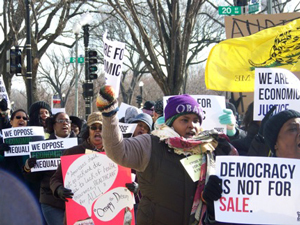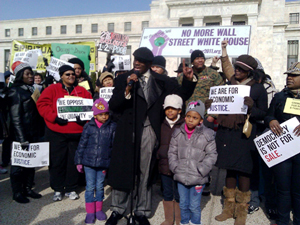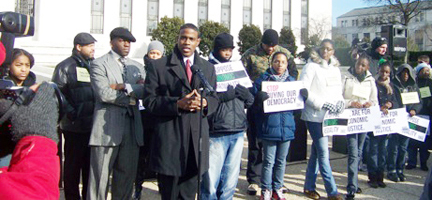Occupy the Dream joins the Occupy movement
By Nisa Islam Muhammad -Staff Writer- | Last updated: Jan 27, 2012 - 9:16:56 AMWhat's your opinion on this article?

Occupy the Dream protestors take to the streets for Jan. 16 demonstrations on the King Holiday. Protestors want jobs, more grants for education, an end to foreclosures and other changes. Photos: Demond X
|
Occupy the Dream co-chair Rev. Jamal Bryant of Empowerment Temple in Baltimore explained why they were demonstrating. “We want an increase in federal grants for university education, an end to home foreclosures and a $100 billion fund from Wall Street banks for new jobs and neighborhood investment.”
He told The Final Call this was only the beginning. On Feb. 14 the group plans to organize another protest. Rev. Bryant called for 750,000 to one million people to take their money from big banks and open accounts in small community banks and credit unions.

Rev. Jamal Bryant at Occupy The Dream protest in D.C. Photo: OccupyTheDream/Facebook
|
Occupy the Dream had significant turnout in all participating cities. In New York over 500 people attended the Occupy the Dream event, which started with a prayer ceremony at the African Burial Grounds in lower Manhattan led by Queen Mother Delois Blakely.
The demonstration moved to the Federal Reserve Bank, where Bishop Mitchell Taylor led the crowd in prayer and was followed by Dr. Benjamin Chavis, Jr., Latino leader Estelle Velasquez, who is executive president of the 1199 Labor Union, spoke on behalf of unions and Latinos in a show of support for Occupy the Dream.
“We affirm the dream of Reverend Dr. Martin Luther King Jr. for economic justice by protesting today at the Federal Reserve Bank,” Dr. Chavis Jr. told the crowd.
Farajii Muhammad from Baltimore has worked with youth in that city for 10 years. He spoke at the D.C. event representing the voice of Black young people. He told The Final Call, “I’m glad faith leaders are spearheading this event. The Honorable Elijah Muhammad said that when the Black church gets up, it’s only a matter of time for our rise. This is a new consciousness and an organic movement that is an ever evolving process.”

Faraji Muhammad speaks at Occupy The Dream protest in D.C.
|
In addition to Washington, D.C., and New York City, demonstrations were also held in Los Angeles, Baltimore, Oakland, Chicago, Minneapolis, St. Louis and Atlanta.
Protesters in D.C. included Howard University students, Rainbow PUSH and the National Action Network. Rev. Bryant told the crowd, “This is to remind the banks that they work for us and we do not work for them … Occupy is a diverse organization, not White or Black but a reflection of America in its totality.”
James Pitts from Occupy Wall Street was very glad to see the effort. “It’s time we all came together to do this. We are all part of the 99 Percent. This effort is long overdue,” he said.
Occupy the Dream’s demands are similar to the demands of Occupy Wall Street. The Black religious leaders want:
A Constitutional amendment to limit the amount of and role of corporate money in politics;
Full funding of Pell Grants and greater access to low interest student loans;
An end to the Bush era tax cuts that assist the rich;
An immediate end to foreclosures and the development of a plan to put people back in their homes;
Employment and training programs for the returning soldiers who come back and others in need;
Rebuilding the nation’s infrastructure, including bridges, roads, tunnels, highways, etc.
Having the demonstrations on the King Holiday was significant to the organizers.
One of Dr. Martin Luther King’s last acts before his assassination in 1968 was to start the Poor People’s Campaign, which focused on jobs, income and housing for the poor, observed Rev. Bryant. More than 40 years later, Rev. Bryant continued, those issues are more important than ever.
INSIDE STORIES AND REVIEWS
-
-
About Harriett ... and the Negro Hollywood Road Show
By Rabiah Muhammad, Guest Columnist » Full Story -
Skepticism greets Jay-Z, NFL talk of inspiring change
By Bryan 18X Crawford and Richard B. Muhammad The Final Call Newspaper @TheFinalCall » Full Story -
The painful problem of Black girls and suicide
By Charlene Muhammad -National Correspondent- » Full Story -
Exploitation of Innocence - Report: Perceptions, policies hurting Black girls
By Charlene Muhammad -National Correspondent- » Full Story -
Big Ballin: Big ideas fuel a father’s Big Baller Brand and brash business sense
By Bryan Crawford -Contributing Writer- » Full Story






 Click Here Stay Connected!
Click Here Stay Connected!








